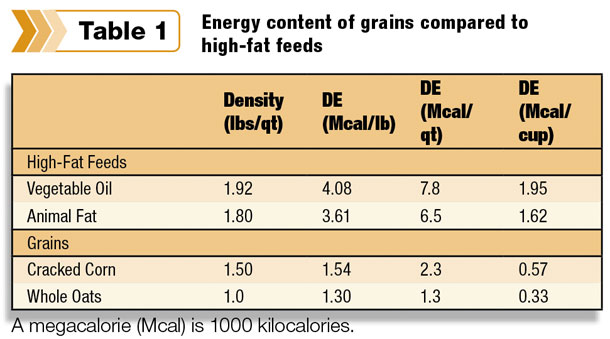The benefits
On high-fat diets, horses perform longer without fatiguing, incur fewer injuries and maintain bodyweight with less grain intake while maximizing forage intake.
Adding fat to a horse’s diet permits safe weight gain while reducing the chance of colic or founder; it may also allow lactating mares to breed back more quickly. Digestion of fat yields less internal body heat when compared to high-carbohydrate or high-protein diets.
Most importantly, perhaps, high-fat diets enable horses in high-performance situations – for example, while pregnant, lactating or working at moderate and intense levels – to more efficiently and safely meet their high energy requirements.
Unfortunately, the horse’s relatively small digestive tract limits the total volume of feed it can consume. As a result, horses requiring high energy intake must be fed an energy-dense concentrate mix.
Traditionally, this has been accomplished by increasing the concentrate (high-energy) portion of the diet while limiting forage intake. Forages, such as hay and pasture, are more fibrous and lower in energy than the grains found in concentrate mixes.
Under ideal management conditions, a horse should consume no less than 50 percent of its daily intake in the form of forage. Horses that are “hard keepers” and maintain low body fat reserves typically require greater than a 50 percent daily intake of concentrates to maintain their bodyweight during high-production situations.
Unfortunately, the replacement of forage with high-starch concentrates in levels greater then 50 percent of the total diet negatively affects the pH and activity of the digestive microbes found in the horse’s cecum and large intestine. The net effect is an increased incidence of founder and colic.
Energy comparisons
Since fat contains 2.25 times more energy than either carbohydrates or protein, increasing the fat level of the diet is the easiest and safest way to increase the energy density of the diet. Higher energy levels can be obtained by feeding fewer pounds of a high-fat concentrate mix compared to a concentrate mix containing lower-energy carbohydrates.

Farm grains, such as corn and oats, are high in carbohydrates but fairly low in fat. High-fat sources such as soybean oil, corn oil and animal fat contain three times more energy than grains on an equal volume basis (Table 1).
Research has indicated that adding 5 percent to 10 percent fat to the total diet has maintained the bodyweight of horses with a 21 percent to 25 percent decrease in concentrate intake.
Concentrate mixes comprised of grains without supplemental fat added will contain 2 percent to 2.5 percent fat. Vegetable oils, such as corn or soybean oil, are more palatable than processed animal fat.
Rice bran is another high-fat source that is both palatable and effective in horse diets. The horse can consume a concentrate mix with as much as 15 percent added fat without palatability or digestive problems such as diarrhea.
However, research reveals that a fat level of 6 percent to 8 percent in concentrate mixes will produce performance results similar to fat levels of 10 percent to 20 percent and will cost considerably less. Most commercial feed companies add vegetable oils to the concentrate mix to produce a 5 percent to 8 percent fat content.
Switching horses from a carbohydrate concentrate to a high-fat concentrate mix (greater than 8 percent fat) should be done gradually over several days. The higher fat intake may initially produce a looser stool. Allow at least 21 days for the high-fat diet to affect your horse’s performance and improve feed efficiency.
Traditionally, horse owners have supplemented 1 to 2 ounces of corn oil daily to improve hair-coat sheen. A significantly higher level of supplemental fat or oil is required to affect the energy intake and enhance your horse’s performance. Replacement of 10 percent of the recommended grain intake with a high-fat source will improve energy intake.
Vegetable oil sources are about three times as expensive as farm grains. Generally, it is more economical to purchase a high-fat commercial grain mix when supplementation of more than 0.5 pounds of fat are required per day.
Fat is an important energy source for the high-performance horse. High-fat diets provide a safe, efficient energy source that will improve your horse’s performance, minimize the risk of colic and founder, and usually be more cost-effective.
Fat supplementation to horses at different performance levels
Example One
1,100-pound show horse at light work (one hour of work five times per week). This includes working hunter, western pleasure and pleasure driving.
- Daily diet without added fat:
- 15 pounds hay
- 5 pounds balanced grain mix
- 20 pounds total feed (digestible energy = 21.9 Mcal)
- 10 percent fat substitution calculation
- 5 pounds grain x 0.1 = 0.5 pound supplemental fat
- New fat-supplemental diet*
- 15 pounds hay
- 4.5 pounds grain mix
- 0.5 pounds (1 cup) corn oil
- 20 pounds total feed (digestible energy = 23.3 Mcal)
Example Two
1,100-pound show horse at moderate work. This includes horses undergoing intense daily training, three-day event horses and competitive driving horses.
- Daily diet without added fat
- 15 pounds good-quality hay
- 10 pounds balanced grain mix
- 25 pounds total feed (digestible energy = 28.8 Mcal)
- 10 percent fat substitution calculation
- 10 pounds grain x 0.1 = 1 pound supplemental fat
- New fat-supplemental diet*
- 15 pounds hay
- 9 pounds grain
- 1 pound (2 cups) corn oil
- 25 pounds total feed (digestible energy = 31.5 Mcal)
- Grain intake may be reduced an additional 10 percent after 21 days of fat supplementation. Adjust grain intake downward to maintain the desired body condition.

Dr. Robert A. Mowrey is an emeritus extension horse husbandry specialist at North Carolina State University. Excerpts from Extension.






